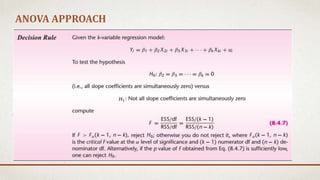Econometrics chapter 8
- 1. CHAPTER 8: MULTIPLE REGRESSION ANALYSIS: THE PROBLEM OF INFERENCE Course: ADVANCED QUANTITATIVE TECHNIQUES Instructor: DR. REHANA KOUSER DEPARTMENT OF COMMERCE, B. Z. UNIVERSITY, MULTAN-PAKISTAN
- 3. CHAPTER OUTLINE 1. Testing hypotheses about an individual partial regression coefficient 2. Testing the overall significance of the estimated multiple regression model, that is, finding out if all the partial slope coefficients are simultaneously equal to zero 3. Testing that two or more coefficients are equal to one another 4. Testing that the partial regression coefficients satisfy certain restrictions 5. Testing the stability of the estimated regression model over time or in different crosssectional units 6. 6. Testing the functional form of regression models
- 4. HYPOTHESIS TESTING ABOUT INDIVIDUAL REGRESSION COEFFICIENTS The null hypothesis states that, with X3 held constant, X2 has no influence on Y. We follow same two approaches to test these hypotheses: • First: Confidence Interval Approach • Second: Test of Significance Approach
- 5. TESTING THE OVERALL SIGNIFICANCE OF THE SAMPLE REGRESSION This null hypothesis is a joint hypothesis that β2 and β3 are jointly or simultaneously equal to zero. A test of such a hypothesis is called a test of the overall significance of the observed or estimated regression line, that is, whether Yis linearly related to both X2 and X3. There are two approaches to test this kind of situation: • ANOVA Approach • Using R square Approach
- 8. RELATIONSHIP BETWEEN F AND R SQUARE
- 9. THE “INCREMENTAL” OR “MARGINAL” CONTRIBUTION OF AN EXPLANATORY VARIABLE • By contribution we mean whether the addition of the variable to the model increases ESS (and hence R2) “significantly” in relation to the RSS. This contribution may appropriately be called the incremental, or marginal, contribution of an explanatory variable.
- 10. WHEN TO ADD NEW VARIABLE(S)? When to add new variable? • A formal method of deciding whether a variable should be added to a regression model. Often researchers are faced with the task of choosing from several competing models involving the same dependent variable but with different explanatory variables. • Therefore, if the inclusion of a variable increases R¯ 2, it is retained in the model although it does not reduce RSS significantly in the statistical sense. When to Add a Group of Variables? • If adding (dropping) a group of variables to the model gives an F value greater (less) than 1, R2 will increase (decrease). One can easily find out whether the addition (subtraction) of a group of variables significantly increases (decreases) the explanatory power of a regression model.
- 11. TESTING THE EQUALITY OF TWO REGRESSION COEFFICIENTS
- 13. TESTING RESTRICTIONS: T-STAT APPROACH
- 14. TESTING RESTRICTIONS: T-STAT APPROACH
- 15. TESTING FOR STRUCTURAL OR PARAMETER STABILITY OF REGRESSION MODELS: THE CHOW TEST • When we use a regression model involving time series data, it may happen that there is a structural change in the relationship between the regressand Y and the regressors.
- 16. CHOW TEST
- 17. TESTING THE FUNCTIONAL FORM OF REGRESSION: CHOOSING BETWEEN LINEAR AND LOG–LINEAR REGRESSION MODELS • The choice between a linear regression model (the regressand is a linear function of the regressors) or a log–linear regression model (the log of the regressand is a function of the logs of the regressors) is a perennial question in empirical analysis. We can use a test proposed by MacKinnon, White, and Davidson, which for brevity we call the MWD test, to choose between the two models.
- 18. TESTING THE FUNCTIONAL FORM OF REGRESSION: CHOOSING BETWEEN LINEAR AND LOG–LINEAR REGRESSION MODELS
- 19. TESTING THE FUNCTIONAL FORM OF REGRESSION: CHOOSING BETWEEN LINEAR AND LOG–LINEAR REGRESSION MODELS • If the linear model is in fact the correct model, the constructed variable Z1 should not be statistically significant in Step IV, for in that case the estimated Y values from the linear model and those estimated from the log–linear model (after taking their antilog values for comparative purposes) should not be different. The same comment applies to the alternative hypothesis H1.



















